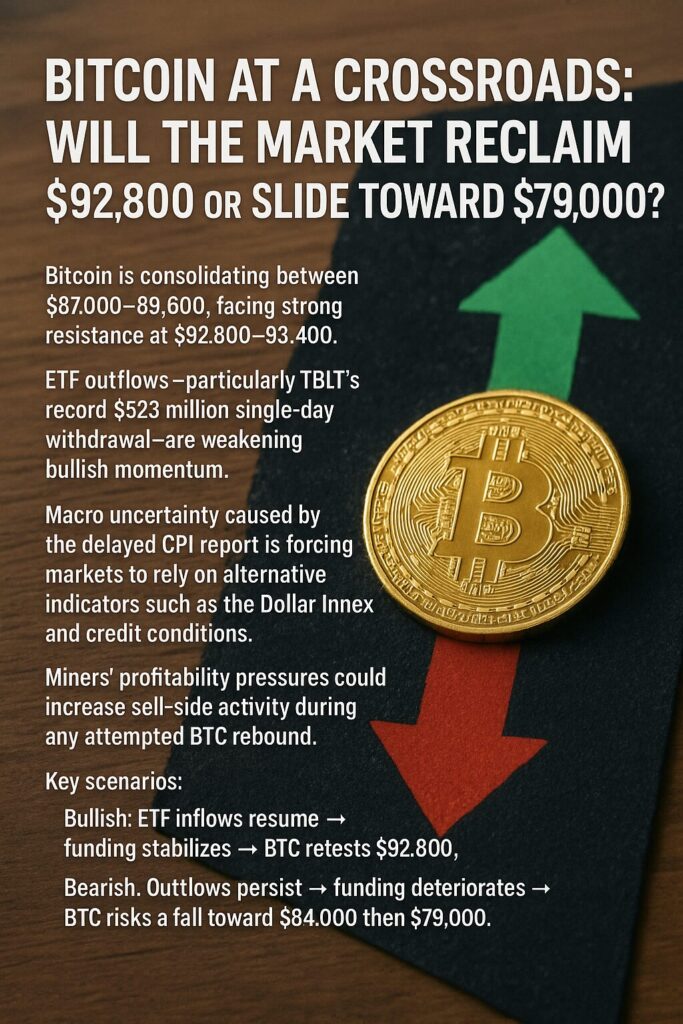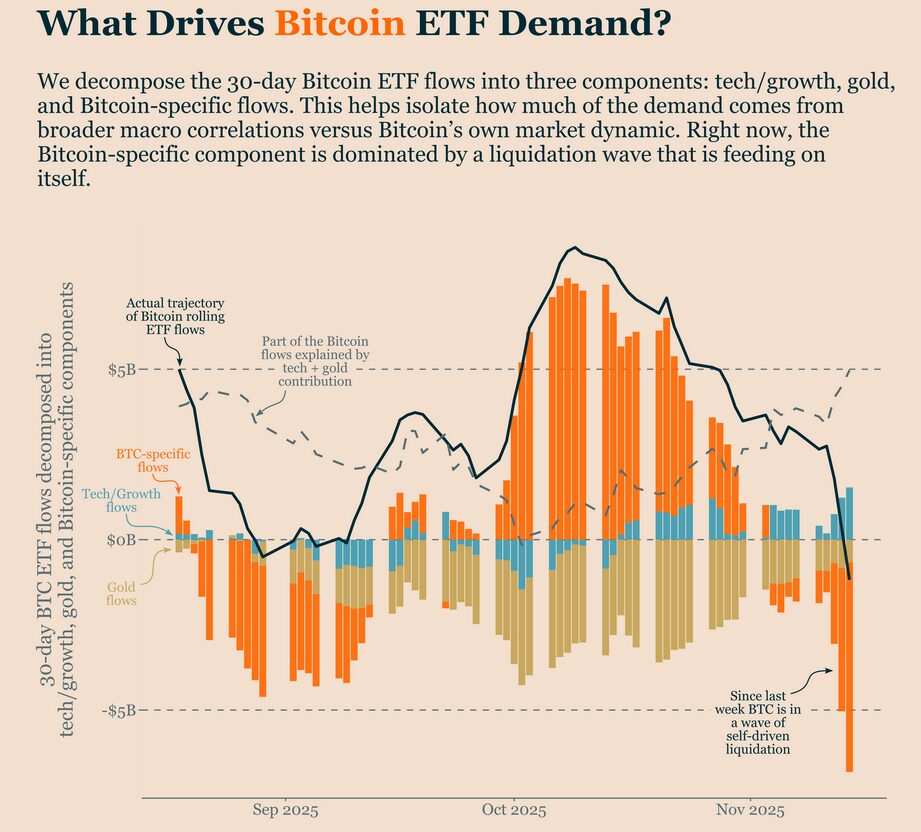
Main Points :
- Bitcoin is consolidating between $87,000–$89,600, facing strong resistance at $92,800–$93,400.
- ETF outflows—particularly IBIT’s record $523 million single-day withdrawal—are weakening bullish momentum.
- Macro uncertainty caused by the delayed CPI report is forcing markets to rely on alternative indicators such as the Dollar Index and credit conditions.
- Miners’ profitability pressures could increase sell-side activity during any attempted BTC rebound.
- Key scenarios:
- Bullish: ETF inflows resume → funding stabilizes → BTC retests $92,800.
- Bearish: Outflows persist → funding deteriorates → BTC risks a fall toward $84,000 then $79,000.
Introduction
Bitcoin has reached a decisive moment. After rebounding strongly from the critical $85,000 support line over the weekend, BTC now trades inside a relatively tight band between $87,000 and $89,600, while investors watch for clues that could determine whether the next major move is upward or downward. What makes the current phase particularly important is that both macroeconomic uncertainty and sudden ETF outflows are applying pressure at the same time—disrupting what had been a relatively stable upward trend only weeks earlier.
Before analyzing the details, it is essential to understand that the current market environment is shaped not only by technical chart patterns but by structural flows from institutional investors and regulatory-related macro delays. The combination of these factors is creating a fragile equilibrium that may break decisively in either direction.

1. Current Market Structure
1.1 Price Range and Resistance Zones
Bitcoin is currently fluctuating between $87,000 and $89,600, with a thick multi-layered resistance wall sitting overhead:
- $92,800–$93,400: The most important resistance; a zone where large selling clusters historically appear.
- $89,600: Intermediate resistance where BTC frequently faces order-book friction.
To the downside, the following support zones are crucial:
- $85,000: Recently tested and held strongly.
- $82,500–$81,500: A demand zone that previously attracted strong spot buyers.
- $79,000: The “final defense line” that, if broken, could shift the mid-term trend from bullish to neutral.
1.2 ETF Outflows Weighing on the Market
What is currently suppressing bullish momentum is not simply technical resistance—it is capital outflow from institutional products.
BlackRock’s IBIT, one of the largest Bitcoin ETFs, saw $523 million in single-day net outflows on November 19, the largest since its launch. Across all digital-asset investment products, weekly outflows have been heavy as well.
Historically, BTC price rallies have been supported by spot ETF inflows. As these inflows slow or turn negative, it removes a major underlying demand engine that typically absorbs sell pressure.
1.3 Liquidation Shock and Short-Term Volatility
BTC recently plunged briefly into the $81,000 range, triggering liquidations totaling over $1.58 billion within a single hour.
This rapid cascade demonstrated how leveraged the market had become and reminded traders that the current environment is highly sensitive to funding imbalances.

2. Macro Environment: Uncertainty Dominates
2.1 CPI Delay and Loss of a Key Anchor
A U.S. government shutdown caused the cancellation of the October CPI report.
This is a critical issue because CPI data directly influences:
- Inflation expectations
- Rate-cut projections
- Risk-asset appetite
With CPI unavailable, the Federal Reserve and investors must rely on secondary signals—making the market more vulnerable to volatility.
2.2 Alternative Indicators Creating a Bearish Tilt
In the absence of CPI, traders are watching the Dollar Index (DXY) and the Chicago Fed’s National Financial Conditions Index (NFCI).
The NFCI currently signals a tightening environment, which tends to:
- Strengthen the dollar
- Weaken risk assets (including BTC)
- Encourage defensive positioning
This macro background is not catastrophic but does limit Bitcoin’s ability to push above critical resistance zones unless new bullish catalysts appear.
2.3 Miner Weakness Adding Structural Pressure
Hashprice—a metric representing miner revenue per terahash—remains depressed relative to operating costs.
When hashprice is low:
- Miners accumulate fewer BTC
- Miners become forced sellers when prices rebound
- This creates sell pressure at the top of each rally
This is an important factor because it means that even if BTC begins recovering toward $92,800, miners may cap that move unless ETF inflows compensate.
3. Scenario Analysis: Two Diverging Paths
3.1 Bullish Case: Recovery Toward $92,800
A bullish breakout scenario requires the following conditions:
- ETF inflows resume, particularly into IBIT and other major U.S. spot ETFs.
- Funding rates stabilize, reducing liquidation risks.
- Macro signals neutralize, especially dollar strength.
If these align, BTC could surge into a sharp short-covering rally, pulling the price up to $92,800, where the next critical test awaits.
In this case:
- Spot buying accelerates
- Derivatives traders unwind bearish positions
- The market enters a sentiment recovery cycle
3.2 Bearish Case: Breakdown Toward $79,000
A bearish scenario unfolds if:
- ETF outflows continue.
- Funding rates deteriorate as retail longs unwind.
- Macro indicators point toward tightening conditions.
In such a scenario, BTC risks:
- Losing $84,000, the first warning threshold
- Testing $82,500–$81,500 as demand weakens
- Ultimately revisiting $79,000, the structural support zone
A breakdown below $79,000 would not necessarily create a long-term bear market, but it would shift the medium-term structure into a broader consolidation phase.
4. What to Watch Next: Key Signals for Crypto Investors
For readers looking for new crypto assets or emerging opportunities, the following indicators are especially important in the coming days:
4.1 ETF Net Flow Trends
This remains the single most influential factor.
Positive inflows → bullish.
Negative inflows → bearish.
4.2 Funding Rates Across Major Exchanges
Stable or neutral funding → balanced market structure.
High funding → crowded long positions that risk liquidation.
Negative funding → potential short squeeze.
4.3 Miner Selling Behavior
If miner outflows rise during price rebounds, it signals overhead pressure.
If miner reserves stabilize, it often aligns with price recovery phases.
4.4 Market Liquidity Conditions
The BTC order-book depth on major exchanges has been thinner recently.
Thinner books → larger price swings for the same amount of capital.
5. Strategic Implications for Investors and Builders
5.1 For Investors Seeking New Assets
Periods of uncertainty often create opportunity:
- Lower prices allow accumulation of long-term assets.
- Short-term volatility helps identify projects with strong fundamentals.
- Correlation among altcoins increases during BTC shakeouts, creating entry points.
5.2 For Blockchain Builders and Entrepreneurs
A volatile market environment increases demand for:
- Stablecoin infrastructure
- Payment rails
- OTC desks
- Non-custodial wallets
- Layer-2 scaling solutions
- On-chain analytics and KYT tools
Projects that solve regulatory and operational pain points tend to outperform during macro pressure.
Conclusion
Bitcoin is currently suspended between two powerful forces: technical resistance around $92,800 and structural risks that could drag it to $79,000.
ETF outflows, macro uncertainty, and miner-related sell pressure are restraining bullish momentum. At the same time, Bitcoin’s long-term structural strength and continued institutional presence prevent a major breakdown—at least for now.
Investors should monitor ETF flows, funding behavior, and macro indicators closely. Whichever direction BTC chooses, it will likely set the tone for the broader crypto market heading into the next cycle. Whether a breakout or breakdown occurs, the volatility itself will continue to create opportunities for those watching carefully.

